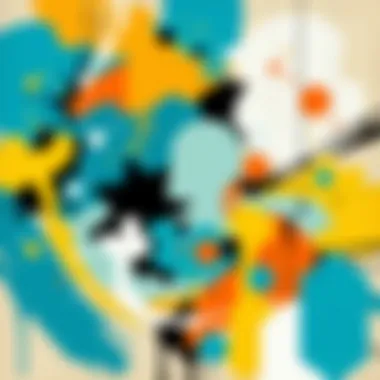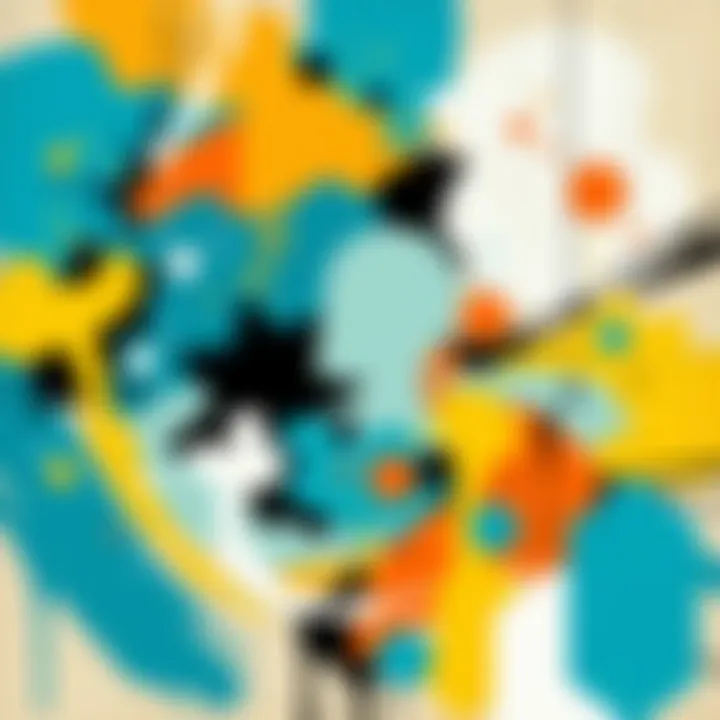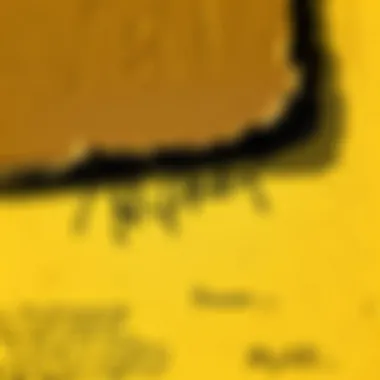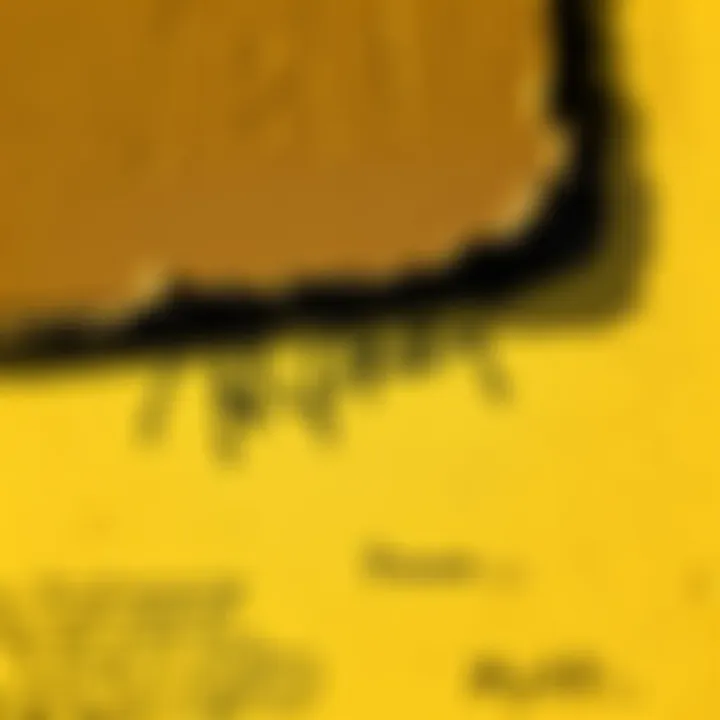Examining Authenticity in Art: Insights and Implications


Intro
In the realm of art, the term authenticity carries a weight that transcends the mere idea of originality. It paints a broad picture filled with nuances that affect artists, collectors, and the art market at large. When one contemplates an artwork's genuine essence, layers of cultural context, technological advancement, and individual perception come into play. This article embarks on a critical examination of authenticity in art, seeking to untangle its complex threads.
The significance of authenticity stretches beyond the canvas, influencing market values and consumer trust. Furthermore, in today's digital age, the definition of what makes art real is rapidly evolving. Questions arise: Is a digitally-created piece any less authentic than a traditional painting? Do social media platforms dilute the genuine appreciation for artistry? These inquiries and more will be explored, shedding light on the ongoing dialogue around artistry and authenticity.
As we navigate through various perspectives, including case studies and expert opinions, this article aims to paint a comprehensive picture of how authenticity shapes not only artistic value but also societal perceptions of art. Let's dive deeper into individual aspects, starting first with the insights technology offers into authenticity.
Defining Authenticity in Art
Understanding what authenticity means in the realm of art is crucial for both creators and consumers alike. It helps set the pace for conversations on everything from market value to cultural relevance. The journey of exploring authenticity invites us to question not just the artwork itself but the entire ecosystem that surrounds it. Why do we assign value to particular pieces while others remain in the shadows? What defines genuine creative expression in a world flooded with reproductions and digital art?
The stakes are high. In a climate where authenticity can drive prices through the roof or keep them at rock-bottom, grasping its definition is not merely academic—it's financial and cultural as well. By dissecting the multifaceted nature of authenticity, we can gain insight into the artist’s intent and the audience's perception. This creates a bridge between historical contexts and contemporary interpretations, allowing us to appreciate art more profoundly.
Historical Perspectives
Historically, the notion of authenticity in art has been influenced heavily by various movements and periods. In the Renaissance era, for instance, originality was tied to the genius of individual artists. Figures like Leonardo da Vinci epitomized this idea, as their unique styles and methods contributed to what was then considered authentic art. Connoisseurs sought out works that bore the distinct touch of these great creators, believing that true value lay in the individual’s capability to inject their personality into their art.
However, as we move into the Baroque and later periods, authenticity began to also encompass the collecting practices and the provenance of artworks. The idea of crafting a narrative around an artwork's journey—from creation to sale—became paramount. Artifacts were not just valued for aesthetics but also for their stories. This historical exploration reveals how the definition of authenticity is not fixed; it evolves with cultural shifts, reflecting what's important to society at a given moment.
Contemporary Interpretations
In today’s world, the definition of authenticity has morphed yet again, diverging into multiple paths of understanding. In an age dominated by technology and digital media, what resonates as authentic can vastly differ from one viewer to another.
Artistic authenticity might now hinge on an artist's voice in relation to societal issues. Think of artists like Banksy or Ai Weiwei, who challenge norms through their work. Here, it's about the message as much as the method. Audiences look for authenticity not just in the paint or canvas but in the urgency of the statement.
Moreover, with the rise of NFTs and digital creations, new parameters are appearing on the authenticity landscape. These platforms introduce questions regarding ownership and originality that the traditional art world hadn't anticipated. It's as if we find ourselves navigating uncharted waters where definitiveness is elusive.
"Art is not what you see, but what you make others see." – Edgar Degas
This quote emphasizes how perceptions of authenticity transcend mere physical presence. It indicates a crucial pivot from art being mostly about the artist’s mark to considering the viewer’s engagement and interpretation.
The Role of the Artist
In the grand tapestry of art, the artist is often seen as the weaver, intricately blending threads of thought, emotion, culture, and personal experience into a cohesive whole. Their role is multifaceted, shaping not just the world of painting or sculpture, but also influencing concepts of authenticity. It raises pivotal questions around intent, expression, and the audience's interpretation. Diving into the significance of the artist in this discussion offers clarity on how authenticity is perceived and valued.
Intent vs. Perception
The tension between intent and perception is a cornerstone of artistic authenticity. Every brushstroke or chisel mark often stems from the creator's intention, a reflection of their thoughts, feelings, and cultural background. However, once an artwork leaves the artist's studio, the perception shifts dramatically. The audience brings their own experiences, biases, and emotions to the piece, interpreting it in ways the creator may not have envisioned.
For instance, consider Pablo Picasso’s "Les Demoiselles d'Avignon." While Picasso’s intent was rooted in breaking away from traditional representations of female figures, the piece has been interpreted through various cultural lenses, from feminist critiques to postmodern analysis. This gap between intent and interpretation plays a crucial role in understanding authenticity. Is a work authentic if it communicates something different from what the artist intended?
"A work of art is a world in itself reflecting senses and emotions of the creator. However, once out in the public, it gets a life of its own – reflective of the viewers’ perceptions as well."
Authenticity in Artistic Practices
When we look at authenticity in artistic practices, we enter a realm shaped by current social movements, technology, and the artist's background. Today, the practice isn't just about the creation of art but also about how artists engage with their identities and environments. Many artists today are leaning into their cultural roots, merging traditional techniques with contemporary themes, which can add layers of authenticity.
Take, for example, the work of Kehinde Wiley. He redefines traditional portraiture by featuring contemporary African-American subjects in poses and settings that echo historical masterpieces. This blend of old and new illustrates authenticity through a dynamic lens—anchoring the past while making bold statements on racial representation today.
Furthermore, artists now often use social media platforms like Instagram to showcase their work. This shift allows them to interact directly with their audience, and in turn, influences how their art is perceived. In this digital age, the artist’s practice becomes not only a reflection of their skills but also a commentary on societal issues, further complicating the notion of authenticity.
Ultimately, the role of the artist is pivotal in shaping discussions around authenticity. They navigate the waters of intent and perception, while their practices directly reflect the evolving cultural landscape. Understanding this role equips us with the insight needed to critically engage with art and its authenticity, opening the door to richer appreciation and discourse.


Cultural Context and Authenticity
In the intricate tapestry of art, cultural context plays a pivotal role in shaping notions of authenticity. It is vital to understand how different cultural backgrounds, histories, and societal values influence what is deemed authentic. With the world becoming an increasingly interconnected place, the lines often blur between cultural appreciation and appropriation. Engaging with this theme not only helps to enrich artistic expression but also serves as a lens through which we can examine the implications of such exchanges.
Cultural context brings depth to artworks, as it encompasses the myriad factors that inform an artist's creations. This could range from the political climate in which they work to the traditions of their homeland that shape their aesthetic decisions. When we talk about authenticity in art, we’re really grappling with the question of how these elements can be preserved or transformed in today’s globalized art market.
Additionally, the benefits of understanding cultural context include:
- Enhancing Interpretation: Audiences gain deeper insights into the significance of works when they analyze them in relation to the artist's cultural influences.
- Fostering Respect: Respect for cultural origins can lead to more meaningful collaborations and exchanges in the art world.
- Encouraging Diversity: Recognizing diverse backgrounds encourages a broader range of artistic expression, inviting fresh perspectives and ideas.
But it is critical to tread carefully, with an awareness of cultural sensitivities. The potential for misrepresentation or commodification of cultures can lead to backlash and accusations of cultural appropriation. This brings us to the next section.
Cultural Appropriation vs. Authentic Expression
Cultural appropriation is a hot-button issue that revolves around the borrowing of cultural elements without permission or understanding, often leading to commodification. This can become problematic, particularly when the borrowing comes from marginalized cultures. On the other hand, authentic expression arises when an artist draws from their own experiences or respectfully engages with another culture, honoring its depth and complexity.
A few examples to consider are:
- Fashion in the Art World: Designers using traditional patterns from Indigenous tribes in their collections without proper acknowledgment can lead to allegations of appropriation.
- Music: Genres like Hip-Hop often integrate diverse influences; however, it is important to recognize the roots from which these styles derive.
"Cultural awareness is crucial not just for the integrity of art, but also for the respect of those who have created it."
Ultimately, walking the line between appropriation and expression is a delicate task for artists today.
The Global Art Market's Influence
The global art market profoundly impacts how authenticity is perceived and valued. With art being a commodity, its worth is often gauged by market dynamics rather than intrinsic qualities. This evolution has introduced both opportunities and challenges for the idea of authenticity.
- Market Trends: As trends shift, artworks that capture public imagination can quickly escalate in value, regardless of their authenticity. Think of the influence of social media on viral art; some pieces become popular not due to their originality, but because they're 'in vogue.'
- Galas and Auctions: Auction houses like Sotheby’s or Christie's set benchmarks for what is classified as authentic and valuable, reinforcing certain narratives and potentially sidelining others.
- Digital Transformation: The rise of online galleries and platforms allows for global accessibility but simultaneously raises concerns about the verification of authenticity, especially with fraudulent works becoming increasingly sophisticated.
In a world where the market often dictates value, understanding the intricate relationship between cultural context and the global art market is essential for both artists and collectors. It raises pertinent questions about what constitutes authenticity in a rapidly changing environment, pushing individuals to critically reflect on their engagement with art.
The Impact of Technology
In recent years, one cannot help but notice how the rapid advancement of technology has carved out new realms in the art world. What used to be the domain of traditional canvas and paint is now a hybrid landscape of digital canvases, 3D installations, and virtual galleries. Technology's thumbprint on authenticity is profound, shifting not just how art is created but also how it is perceived, valued, and even sold.
This exploration of technology's impact on authenticity encompasses elements that span from digital artistry to blockchain's revolutionary role in provenance. The intersection between these innovations and traditional concepts of authenticity presents both opportunities and challenges that are worth delving into deeply.
Digital Art and Authenticity
Digital art has become an undeniable force in contemporary artistic expression. From digital painting to algorithmic design, artists are exploring new mediums that push boundaries and enter uncharted territory.
The question arises: How does one measure authenticity in a realm where the art can be infinitely replicated, altered, or even generated by artificial intelligence?
- Uniqueness: In the traditional art world, a unique piece often commands a higher value largely due to its scarcity. However, in the digital realm, this notion becomes hazy. Can a digital artwork be considered authentic if it exists in numerous copies across the web?
- Ownership: Unlike physical art, where ownership is often conveyed through a tangible object, digital pieces demand a different kind of authentication. This leads us into a world where files and metadata become crucial players in validating an artwork’s claim to authenticity.
- Perception: Audience perception also plays a huge role. A digital work created by a recognized artist might hold more clout than a piece created by a relatively unknown talent, despite both works being deemed "authentic" based on their creator's technique and intention.
"Digital art challenges the status quo of authenticity, blurring lines between original and replica, artist and audience."
Blockchain and Provenance
Blockchain technology has been heralded for its potential to reshape many industries, and the art world is no exception. This decentralized ledger technology holds the promise of transforming how provenance—a key component of authenticity—is established in both digital and physical art markets.
How does blockchain achieve this? Here are a few highlights:


- Immutable Records: Each transaction or change of ownership is recorded on the blockchain, providing an indelible record of an artwork’s history. This traceability combats forgery and ensures buyers can confidently claim ownership of an authentic piece.
- Smart Contracts: Blockchain enables smart contracts that can automatically execute and enforce the terms surrounding usage, copyrights, and resale. Such mechanisms help artists retain a level of control over their work, ensuring they reap the benefits of secondary sales.
- Global Acceptance: As the adoption of blockchain grows, so does the confidence in the authenticity claims it supports. Galleries and collectors may increasingly rely on blockchain data to establish trust in the artworks' backgrounds, leading to a more transparent marketplace.
In the era where digital art and blockchain coexist, the landscape of authenticity is rapidly evolving. Art now exists in a dual reality, one that is both tangible and intangible, pushing both artists and audiences to reconsider what authenticity truly means.
Perceptions of Value
Understanding how value is perceived in art is pivotal because it directly influences the decisions of artists, collectors, and critics alike. In an industry where emotion often intertwines with economics, the various factors that contribute to an artwork's value cannot be overstated. When we peel back the layers, we uncover how perceptions are shaped by market dynamics, cultural significance, and individual expectations—all of which shape the narrative surrounding authenticity in art.
Market Dynamics
The market for art is anything but static; it ebbs and flows like the tide. Prices can swing dramatically based on trends, overall economic conditions, or even the latest celebrity endorsement. As such, market dynamics play a crucial role in determining what is considered valuable. For instance, consider how auction houses such as Sotheby's and Christie's operate. They often create a buzz around specific pieces, boosting their perceived value remarkably.
- Branding and Prestige: The reputation of an artist or an art gallery significantly impacts the perceived value. A piece from a renowned artist can fetch millions, while a lesser-known name might struggle to get noticed, regardless of the artwork's intrinsic quality or message.
- Speculation and Investment: Many collectors view artwork as a commodity. They buy not just for appreciation but for potential financial gain. This speculative behavior can inflate values, leading to the creation of 'bubble' effects.
- Cultural Trends: Just like fashion, art is susceptible to cultural trends. An artwork that captures the spirit of the times or addresses pertinent issues can spike in value as collectors and institutions seek to align with social movements. For example, contemporary works that challenge societal norms often garner attention and appreciation, affecting their market worth.
By recognizing these dynamic elements, one can grasp that art’s value isn’t solely dictated by an artist’s skill but rather an intricate web of perception and context.
Buyer Expectations
The expectations that potential buyers bring to the table shape their decisions remarkably. When individuals set out to acquire art, it’s often not just about the visual appeal but about what the piece signifies, represents, or conveys about their identity or values.
- Investing in Identity: Buyers often seek pieces that resonate with their personal narrative or philosophical stance. This phenomenon can lead to artworks being valued not just for their aesthetic but also for their ability to represent social or cultural affiliations.
- Authenticity as Luxury: In a world swamped with reproductions and digital copies, authenticity often translates into a luxury marker. Buyers frequently demand provenance and documentation to justify the value of their acquisitions, adding another layer to the discussion of authenticity.
- Emotional Connection: Many collectors feel a profound emotional bond with certain works. This connection can elevate a piece’s value far beyond its market price, making it priceless in the eyes of the purchaser. A piece of art that resonates on a deeply personal level could overshadow all logic regarding pricing.
In summary,
The perceptions surrounding the value of art are not just a reflection of monetary figures but rather a mosaic of personal and cultural narratives.
As we navigate through the complexities of art’s authenticity, it's essential to realize that the calculations of value are frequently more subjective than they seem. As artists and collectors alike come to grips with this reality, the conversation about what is deemed authentic will continue to evolve.
Case Studies
Case studies provide insight into the practical implications of authenticity in art. They allow us to dissect individual instances, leading to a deeper understanding of the broader issues in art and authenticity. By examining both famous fakes and examples of authentic art, we can reveal the elements that contribute to its value and perception. Here, we look at specific examples that encapsulate the challenges and triumphs surrounding authenticity in the art world.
Notable Instances of Fakes
The art world has seen its fair share of forgeries, some of which had a lasting impact on the market and the perception of authenticity itself. One infamous case involves the painter Han van Meegeren, who created fakes of Vermeer. Van Meegeren managed to sell his works to notable collectors and museums, claiming they were lost Vermeer paintings. His cunning techniques not only deceived art experts but also opened the floodgates for discussions surrounding the criteria that define authenticity.
- The Role of Expertise: Van Meegeren's paintings raised questions about the expertise of art historians and curators.
- Legal and Ethical Ramifications: His story illustrated the legal implications associated with art forgery, where authenticity can lead to criminal charges.
- Impact on Reputations: Institutions like the Rijksmuseum had to grapple with their reputations on the line when they realized that they were misled.
Another striking example is the case of the "Salvator Mundi" attributed to Leonardo da Vinci. Its sale in 2017 for a staggering $450 million stirred debates about attribution, as some experts questioned its veracity. This case exemplifies the intersection of high art and high finance, where perceptions of authenticity drive market dynamics.
Successful Authentic Art
In contrast to the world of fakes, there are artists and movements renowned for their authenticity and the genuine narratives they convey. One prime example is the work of Ai Weiwei. His art often critiques cultural and political issues, deeply rooted in his experiences and identity. Not only does his work retain authenticity, but it also garners respect and resonance in contemporary society.
- Cultural Significance: Ai Weiwei’s installations, such as “Sunflower Seeds,” authentically reflect Chinese culture and history. They connect deeply with audiences and provoke thought on critical issues like freedom of expression.
- Market Value: Works by Ai Weiwei command high prices, as collectors and museums seek out art that is not only aesthetically pleasing but also carries a strong message.
- Legacy and Continuity: His art stands as a testament to the importance of authenticity, serving as a guiding light for emerging artists who wish to express their truths.
These case studies validate that authenticity is not merely a buzzword but a substantial factor that influences perceptions, value, and the trajectory of artistic careers. As art continues to evolve, the ongoing dialogue surrounding authenticity forces us to reconsider what we deem 'real' in the creative landscape.
Philosophical Perspectives
In the realm of art, the concept of authenticity ventures deep into philosophical territory, stirring up questions that can keep one awake at night. Philosophical perspectives on authenticity are pivotal, as they influence how we understand artistic intentions, cultural significance, and the overall value assigned to art. When artists create, they often imbue their works with personal meaning and intention; however, the perception of that authenticity can vary significantly among audiences. This subjective experience highlights critical elements such as the role of intention in art and the viewer's relationship to it.
What Constitutes Authenticity?


At its core, authenticity in art hinges on several factors, the most prominent being the intent of the artist. What the creator walks into the studio, brush in hand—and later, what emerges on the canvas—operates under the umbrella of their authentic voice. Yet, authenticity isn't a singularly defined term; it evolves with time, cultural shifts, and technological advancements. One could argue that a work's origin, including its creator's life experiences and cultural background, plays a crucial role in whether it's deemed 'authentic'. As such, works inspired by personal stories or cultural heritage often carry more weight than pieces created without substantial context.
However, let’s not forget the growing debate surrounding reproduction and re-interpretation in modern art. For instance, consider how Pablo Picasso’s works have sparked numerous imitations. Would an imitation be considered inauthentic if it mimics the original’s spirit? Or, is capturing the essence of a moment, even if through a modern lens, still a testament to authenticity?
Thus, when examining what constitutes authenticity, we arrive at a fork in the road: does the original artist matter more than the viewer's experience and interpretation? Philosophical inquiry urges art connoisseurs to reflect not just on the tangible but on the intrinsic qualities that lead to a deeper understanding of artistic value.
The Subjectivity of Value
When one discusses authenticity, it naturally transitions into the concept of value—particularly its inherent subjectivity. What resonates with one individual might fall flat with another. The values assigned to art pieces often spring from diverse factors: cultural background, personal experiences, and even current societal trends. For example, a piece crafted in a modest studio might gain immense value simply because of its connection to a historical event.
This subjectivity extends to cultural contexts. An artwork that is seen as authentic in one community might be considered superficial or even exploitative in another. These variances illuminate how authenticity isn’t just a black-and-white issue but rather exists in a kaleidoscope of interpretations and emotions.
"Authenticity is an idea shaped by our beliefs and perceptions, often leaving us in a complex dance of opinions and values."
To add more depth, consider how the digital realm reshapes our understanding of value through instant accessibility and wide dissemination. As ideas circulate faster than ever, this liquidity can either dilute authenticity or elevate it, depending on perspective. The dialogue surrounding authenticity in art is a living entity, morphing over time as society evolves.
In essence, philosophical perspectives inform not only our appreciation of art but also our understanding of its value. By delving into this aspect, art enthusiasts might forge stronger connections with artworks, engaging in a discourse that captures the very essence of what it means to experience art in an 'authentic' way.
The Future of Authenticity in Art
The concept of authenticity in art is ever-evolving. As societal values shift and technology advances, artists, collectors, and critics alike must grapple with what authenticity means in the contemporary art landscape. Understanding the future of authenticity is not just about tracking trends; it’s essential to grasp how these changes will impact the value, appreciation, and very fabric of artistic expression.
The importance of exploring the future of authenticity lies in the intersection of cultural shifts and technological innovations. By engaging with this subject, one can better understand how the art world will adapt, what new barriers or opportunities may arise for artists, and how consumers will navigate this changing landscape.
Emerging Trends
Several key trends are heating up the conversation surrounding authenticity in art. These include:
- Digitally Native Artists: The rise of artists who create exclusively in digital formats or explore new media forms is gaining momentum. Their work often challenges traditional notions of what’s authentic, as these pieces can be easily reproduced, manipulated, or altered.
- NFTs (Non-Fungible Tokens): This technology has disrupted the art world, allowing digital artworks to be sold as unique items on the blockchain. The NFT boom reflects a significant shift in how authenticity and ownership are perceived.
- Sustainability Movement: As environmental concerns gain traction, many artists are re-evaluating their practices to align with sustainable values. Authenticity increasingly incorporates ethical considerations, compelling artists to adopt eco-friendly methods.
- Diverse Voices: The art world is gradually becoming more inclusive. Authenticity is also seen through the unique cultural lenses of traditionally marginalized artists, leading to richer narratives in contemporary art.
These trends indicate a crucial transformation in how we define, perceive, and value authenticity, suggesting that tomorrow's art will look very different from today’s.
Evolving Definitions
As we look ahead, definitions of authenticity in art are bound to undergo significant transformations. Some of the evolving discussions include:
- Shifting Value Systems: In a world where digital art and traditional mediums coexist, what defines a 'valuable' artwork might change. The value of a piece might increasingly rely on its conceptual depth rather than its material integrity.
- Cultural Authenticity vs. Commercial Success: While some artists may focus on staying true to their cultural roots, there may be pressure to adapt works for broader market appeal. This tension raises questions about the commodification of culture.
- Authenticity in Collaboration: Artists are increasingly collaborating across disciplines and mediums. There is a growing recognition that authenticity may not stem from individual expression alone but rather emerge from collective creativity. This shift challenges the traditional view of the solitary artist as the source of authentic expression.
The evolving definitions serve as a reminder that authenticity is not static; it continually morphs as contexts shift and intersect. As the future unfolds, so will our understanding of what it means for art to be authentic.
"The only thing constant in life is change." - Heraclitus
By examining these emerging trends and evolving definitions, we equip ourselves with the tools to navigate the intricate landscape of art authenticity, ensuring we cultivate an appreciation that resonates with the present and future generations.
Culmination
In light of the exploration conducted throughout this article, the theme of authenticity presents itself as a crucial pillar in the art discourse. Understanding authenticity in art does not merely address whether a piece is genuine or a forgery; it opens up a nuanced dialogue about cultural significance, artist intention, and the evolving nature of taste and value within the art world.
Reflecting on the previous sections, it becomes apparent that authenticity is not just a static definition but a fluid concept, shaped by time, culture, and technological advancements.
Reflecting on Authenticity
As we ventured through the varied dimensions of authenticity, it is clear that our perceptions are often clouded by personal biases and societal standards. Authenticity can sometimes be a double-edged sword; what is deemed 'authentic' might not resonate with everyone the same way. For instance, a critically acclaimed piece may be viewed as inauthentic by certain subcultures that prioritize different artistic values or practices.
Moreover, the accessibility of information in the digital age has also transformed our understanding of what authentic means. Artists now connect with audiences without geographical limitations, enabling diverse interpretations and blurred lines between original works and copies. Hence, it is essential to adopt a reflective stance when considering authenticity. Rather than locking it into rigid definitions, one must embrace its dynamic nature and appreciate how it relates to contemporary society's values.
Future Implications for Artists and Consumers
Looking ahead, the implications of this ongoing discourse cannot be overstated. Certainly, artists who understand the complexities of authentic expression can cultivate deeper connections with their audience. They have the opportunity to leverage technology to their benefit, exploring new forms of art that respond to current realities and sentiments.
For consumers, particularly art aficionados and collectors, awareness about the authenticity of art can enhance their appreciation and investment decisions. They may become more discerning, educated about the nuances surrounding authenticity. The digital landscape, filled with artistic possibilities, holds the potential for both profound benefit and significant risk. With emerging trends such as NFTs and blockchain technology, the way we approach authenticity, value, and ownership could drastically change.







